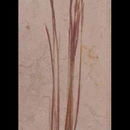Description
provided by eFloras
Annual; culms 3-45cm high, usually erect. Leaf-blades 1-10 cm long, up to 2 mm wide, rough on the margins, minutely hairy above. Inflorescence a sparingly branched, erect or sometimes slightly nodding panicle or raceme, 3-20cm long; pedicels 0.2-2mm long. Spikelets 5-10.5mm long (excluding the awns), breaking up at maturity below each fertile floret; the lower 1-3 florets fertile, the upper 3-7 sterile and usually with longer and wider lemmas with shorter awns. Lower glume 0.1-mm long, less than a quarter the length of the upper; upper glume 1.5-4mm long, acute but often appearing truncate or obtuse because of the deciduous apex; fertile lemma 4-6.5mm long, with an awn usually 1-2 times as long, finely 3-nerved or with 2 extra short nerves, pubescent to ciliate (or glabrous in Europe); anthers 1(-3), 0.4-0.6(-1.6)mm long, included at anthesis.
- license
- cc-by-nc-sa-3.0
- copyright
- Missouri Botanical Garden, 4344 Shaw Boulevard, St. Louis, MO, 63110 USA
Physical Description
provided by USDA PLANTS text
Annuals, Terrestrial, not aquatic, Stems nodes swollen or brittle, Stems erect or ascending, Stems geniculate, decumbent, or lax, sometimes rooting at nodes, Stems caespitose, tufted, or clustered, Stems terete, round in cross section, or polygonal, Stem internodes hollow, Stems with inflorescence less than 1 m tall, Stems, culms, or scapes exceeding basal leaves , Leaves mostly cauline, Leaves conspicuously 2-ranked, distichous, Leaves sheathing at base, Leaf sheath mostly open, or loose, Leaf sheath smooth, glabrous, Leaf sheath and blade differentiated, Leaf blades linear, Leaf blades very narrow or filiform, less than 2 mm wide, Leaf blade margins folded, involute, or conduplicate, Leaf blades mostly glabrous, Leaf blades more or less hairy, Ligule present, Ligule an unfringed eciliate membrane, Inflorescence terminal, Inflorescence a contracted panicle, narrowly paniculate, branches appressed or ascending, Inflorescence a dense slender spike-like panicle or raceme, branches contracted, Inflorescence solitary, with 1 spike, fascicle, glomerule, head, or cluster per stem or culm, Inflorescence spike linear or cylindric, several times longer than wide, Inflorescence single raceme, fascicle or spike, Inflorescence with 2-10 branches, Inflorescence branches 1-sided, Flowers bisexual, Spikelets pedicellate, Spikelets laterally co mpressed, Spikelet less than 3 mm wide, Spikelets with 3-7 florets, Spikelets solitary at rachis nodes, Spikelets all alike and fertille, Spikelets bisexual, Spikelets disarticulating above the glumes, glumes persistent, Spikelets disarticulating beneath or between the florets, Spikelets secund, in rows on one side of rachis, Rachilla or pedicel glabrous, Glumes present, empty bracts, Glumes 2 clearly present, Glumes distinctly unequal, Glumes shorter than adjacent lemma, Glumes 1 nerved, Lemmas thin, chartaceous, hyaline, cartilaginous, or membranous, Lemma 3 nerved, Lemma 5-7 nerved, Lemma glabrous, Lemma rugose, with cross wrinkles, or roughened, Lemma apex acute or acuminate, Lemma distinctly awned, more than 2-3 mm, Lemma with 1 awn, Lemma awn less than 1 cm long, Lemma awned from tip, Lemma awns straight or curved to base, Lemma margins thin, lying flat, Lemma straight, Palea present, well developed, Palea membranous, hyaline, Palea about equal to lemma, Palea 2 nerved or 2 keeled, Palea keels winged, scabrous, or ciliate, Stamens 1, Styles 2-fid, deeply 2-branched, Stigmas 2, Fruit - caryopsis, Caryopsis ellipsoid, longitudinally grooved, hilum long-linear.


![]() This article incorporates text from a free content work. Licensed under CC0 (license statement/permission). Text taken from Vulpia ciliata, . Encyclopedia of Life.
This article incorporates text from a free content work. Licensed under CC0 (license statement/permission). Text taken from Vulpia ciliata, . Encyclopedia of Life.